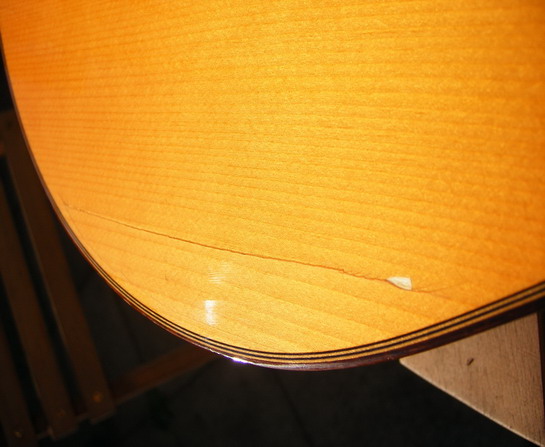Welcome to one of the most active flamenco sites on the Internet. Guests can read most posts but if you want to participate click here to register.
This site is dedicated to the memory of Paco de Lucía, Ron Mitchell, Guy Williams, Linda Elvira, Philip John Lee, Craig Eros, Ben Woods, David Serva and Tom Blackshear who went ahead of us.
We receive 12,200 visitors a month from 200 countries and 1.7 million page impressions a year. To advertise on this site please contact us.
|

|
|
Big Crack
|
You are logged in as Guest
|
|
Users viewing this topic: none
|
|
Login  | |
|

  
Anders Eliasson
Posts: 5780
Joined: Oct. 18 2006

|
 RE: Big Crack (in reply to Stu) RE: Big Crack (in reply to Stu)
|
|
|
Hi Stu.
Of course it can be repaired and I will advice you to do so.
The guitar cracked when you hit the chair, but it was just waiting for a reason to crack. It has most probably dried out to much. and maybe it was built under humid conditions.
First of all get some humidity in the guitar. Leave it in its case laying down, put some plastic in the bottom of the guitar (inside) and a humid sponge above the plastic. (humid, not wet!!!!!!!!!!!!) Its important that the sponge wont come in contact with any wood!!!!!
Leave it like that for 24 hours, take the sponge out and leave the guitar for anther 24 hours.
Examin the guitar. Is the crack open? If not, let some very thin superglue (Stewmacs number 10 is the best I know) seep into the crack. Repeat a couple of times so the it get filled up completely. Let it dry for the night. The exess superglue you can scrape off with a thin cabinet scraper.
I have repaired cracks which were worse like that.
If, after having given the guitar some humidity, the crack stays open, the best is to glue in some small wooden pieces called diamongs on the inside of the soundboard or if its very open make a wooden piece that fits into the crack.
From what I see, the first option should be the best.
The guitar has a VERY wide grained soundboard of a mediocre quality. I find it impressive that Alhambra uses such cheap wood. They may have payed 3 - 5 euros for that soundboard (Buying big quantity). Why cant they afford someting less mediocre that cost 20,-€. I mean the 7 fs is not a cheap guitar.
Good luck with the repair.
_____________________________
Blog: http://news-from-the-workshop.blogspot.com/
|
|
|
|
REPORT THIS POST AS INAPPROPRIATE |
Date Oct. 9 2008 23:42:30
 |
|
 New Messages New Messages |
 No New Messages No New Messages |
 Hot Topic w/ New Messages Hot Topic w/ New Messages |
 Hot Topic w/o New Messages Hot Topic w/o New Messages |
 Locked w/ New Messages Locked w/ New Messages |
 Locked w/o New Messages Locked w/o New Messages |
|
 Post New Thread
Post New Thread
 Reply to Message
Reply to Message
 Post New Poll
Post New Poll
 Submit Vote
Submit Vote
 Delete My Own Post
Delete My Own Post
 Delete My Own Thread
Delete My Own Thread
 Rate Posts
Rate Posts
|
|
|
Forum Software powered by ASP Playground Advanced Edition 2.0.5
Copyright © 2000 - 2003 ASPPlayground.NET |
0.0625 secs.
|


 Printable Version
Printable Version












 New Messages
New Messages No New Messages
No New Messages Hot Topic w/ New Messages
Hot Topic w/ New Messages Hot Topic w/o New Messages
Hot Topic w/o New Messages Locked w/ New Messages
Locked w/ New Messages Locked w/o New Messages
Locked w/o New Messages Post New Thread
Post New Thread